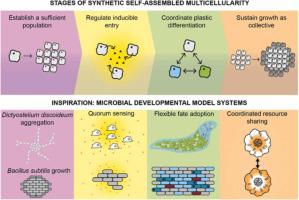Seminars in Cell & Developmental Biology ( IF 6.2 ) Pub Date : 2022-05-07 , DOI: 10.1016/j.semcdb.2022.04.014
Chiara Ricci-Tam 1 , Sophia Kuipa 1 , Maya Peters Kostman 2 , Mark S Aronson 1 , Allyson E Sgro 3

|
While the field of synthetic developmental biology has traditionally focused on the study of the rich developmental processes seen in metazoan systems, an attractive alternate source of inspiration comes from microbial developmental models. Microbes face unique lifestyle challenges when forming emergent multicellular collectives. As a result, the solutions they employ can inspire the design of novel multicellular systems. In this review, we dissect the strategies employed in multicellular development by two model microbial systems: the cellular slime mold Dictyostelium discoideum and the biofilm-forming bacterium Bacillus subtilis. Both microbes face similar challenges but often have different solutions, both from metazoan systems and from each other, to create emergent multicellularity. These challenges include assembling and sustaining a critical mass of participating individuals to support development, regulating entry into development, and assigning cell fates. The mechanisms these microbial systems exploit to robustly coordinate development under a wide range of conditions offer inspiration for a new toolbox of solutions to the synthetic development community. Additionally, recreating these phenomena synthetically offers a pathway to understanding the key principles underlying how these behaviors are coordinated naturally.
中文翻译:

微生物发育模型:工程自组装合成多细胞性的灵感
虽然合成发育生物学领域传统上侧重于研究后生动物系统中丰富的发育过程,但一个有吸引力的替代灵感来源来自微生物发育模型。微生物在形成新兴的多细胞集体时面临着独特的生活方式挑战。因此,他们采用的解决方案可以激发新型多细胞系统的设计。在这篇综述中,我们剖析了两种模型微生物系统在多细胞发育中采用的策略:细胞粘液霉菌盘基网柄菌和生物膜形成细菌枯草芽孢杆菌. 两种微生物都面临着相似的挑战,但通常有不同的解决方案,无论是来自后生动物系统还是彼此,以创造新兴的多细胞性。这些挑战包括聚集和维持足够数量的参与个体以支持发育、调节发育进入和分配细胞命运。这些微生物系统利用在各种条件下稳健协调发育的机制为合成开发社区的新解决方案工具箱提供了灵感。此外,综合重建这些现象提供了一种途径,可以理解这些行为如何自然协调的关键原则。































 京公网安备 11010802027423号
京公网安备 11010802027423号